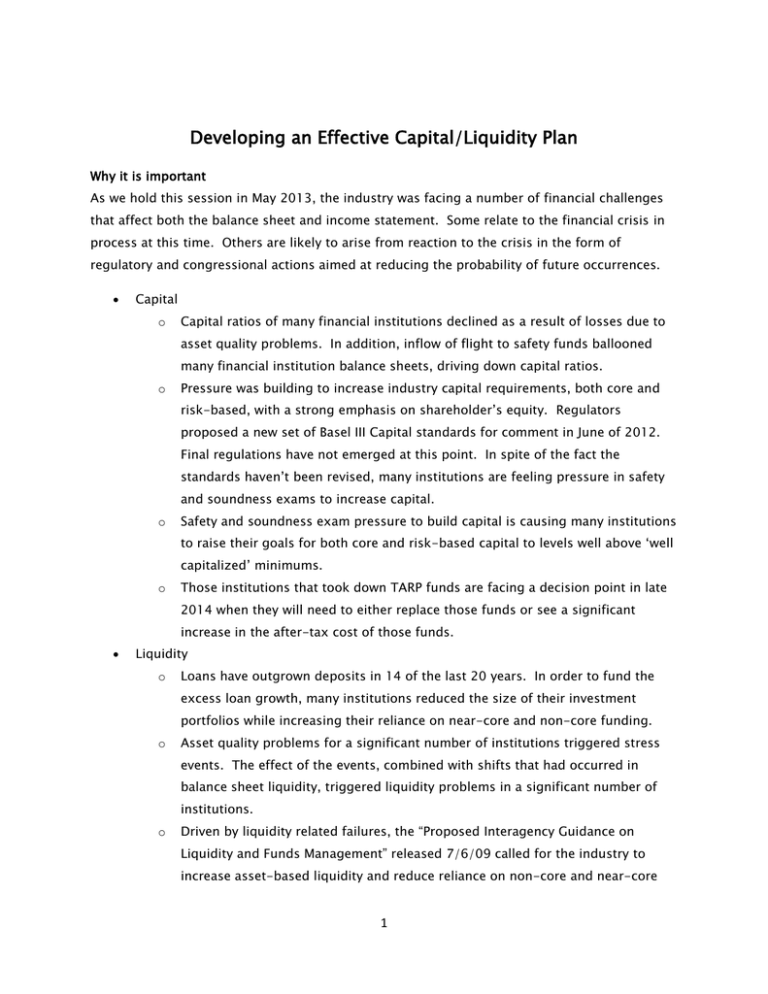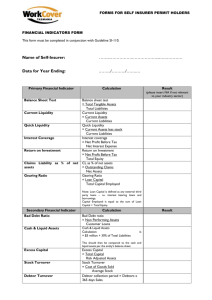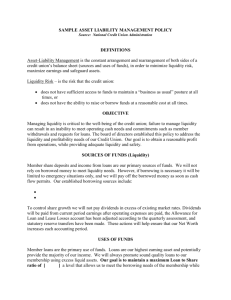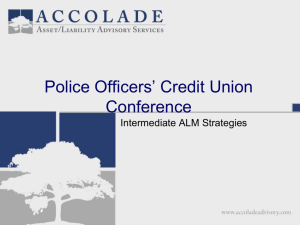Developing an Effective Capital/Liquidity Plan
advertisement

Developing an Effective Capital/Liquidity Plan Why it is important As we hold this session in May 2013, the industry was facing a number of financial challenges that affect both the balance sheet and income statement. Some relate to the financial crisis in process at this time. Others are likely to arise from reaction to the crisis in the form of regulatory and congressional actions aimed at reducing the probability of future occurrences. Capital o Capital ratios of many financial institutions declined as a result of losses due to asset quality problems. In addition, inflow of flight to safety funds ballooned many financial institution balance sheets, driving down capital ratios. o Pressure was building to increase industry capital requirements, both core and risk-based, with a strong emphasis on shareholder’s equity. Regulators proposed a new set of Basel III Capital standards for comment in June of 2012. Final regulations have not emerged at this point. In spite of the fact the standards haven’t been revised, many institutions are feeling pressure in safety and soundness exams to increase capital. o Safety and soundness exam pressure to build capital is causing many institutions to raise their goals for both core and risk-based capital to levels well above ‘well capitalized’ minimums. o Those institutions that took down TARP funds are facing a decision point in late 2014 when they will need to either replace those funds or see a significant increase in the after-tax cost of those funds. Liquidity o Loans have outgrown deposits in 14 of the last 20 years. In order to fund the excess loan growth, many institutions reduced the size of their investment portfolios while increasing their reliance on near-core and non-core funding. o Asset quality problems for a significant number of institutions triggered stress events. The effect of the events, combined with shifts that had occurred in balance sheet liquidity, triggered liquidity problems in a significant number of institutions. o Driven by liquidity related failures, the “Proposed Interagency Guidance on Liquidity and Funds Management” released 7/6/09 called for the industry to increase asset-based liquidity and reduce reliance on non-core and near-core 1 funding. The final version of this guidance document was released on April 5, 2010. o The unreleased Basel III Liquidity Regulation would appear to focus strongly on increasing asset-based liquidity in the form of unencumbered highly liquid marketable securities. Acceptable levels are based on results of institutionspecific liquidity stress tests. o Flight to safety fund inflows from the stock and bond markets increased levels of core funding while reduced demand for quality loans, caused loans to decline. Both of these factors eased liquidity strains on many institutions. However, as the economy turns around, flight to safety funds may flow back to the markets while quality loan demand will increase. As this happens, many institutions will face renewed liquidity challenges. Income o Most institutions were working their way through asset quality problems. In some cases the problem was moderate, while in others, severe. Asset quality problems provide a hit to earnings as a result of increased charge-offs and the need to increase the allowance for loan losses. o The mortgage refinance boom at the bottom of the rate cycle was producing significant fee income for institutions originating and selling in the secondary market. An uptick in rates could choke off the refinance oriented fee income. o A decision to shift assets from loans to highly liquid marketable securities in order to react to regulatory pressures to increase asset-based liquidity would have a negative effect on yield on earning assets. o Pressure to shift non-core and near-core funding into core funding at the time when many other institutions are planning to do the same is likely to result in an increase in the cost of funds. o Increases in operating expenses due to the effect of asset quality problems on collection efforts, legal expenses, and asset-management costs is likely to be felt in at least 2011 and 2012 for those institutions with significant asset quality problems. o Higher capital standards and institution goals may lead to a reduction in financial leverage, with a resulting negative effect on ROE and earnings per share. 2 Objectives of a Capital Plan A set of challenges this formidable and complex can only be dealt with by effectively planning for the future in a rolling planning environment. The rolling planning environment should incorporate: A horizon that looks far enough into the future for an institution to have a reasonable chance of reaching its financial goals. For most institutions the horizon needs to be at least three years and can extend to five years. The proposed Basel III Capital regulations phase in over 7 years. A level of aggregation that allows goals to be set for each year of the selected horizon without the strain of being mired in detail in developing the plan. A scope that incorporates the major measures of financial performance. While one of the goals in building a top level capital/liquidity plan is to keep things relatively simple, at the minimum, the plan would need to have the following objectives. 1. Establish long-range financial goals that optimize the relationship between: a. Earnings, capitalization, growth, and dividend policy. b. Equalize the long-term growth rates for core deposits, loans, and assets. c. Settle upon an ideal balance sheet mix: i. On the asset side between loans, investments, and non-earning assets ii. On the funding side between capital core funding, near and non-core funding, and other liabilities. 2. Create a series of annual goals that lead the institution from its current position to its long-range financial goals over an acceptable horizon. 3. Provide a framework for drilling down to greater detail if desired in the following areas. a. Loan portfolio mix and regulatory capital requirements. b. Investment portfolio mix, risk-based capital assignments, and policy limits c. Non-earning asset mix and risk-based capital assignments d. Core funding mix e. Non-core and near-core funding mix and policy limits f. Capital mix (tier one and tier 2) 4. Provide reporting in the following areas a. Base plan sources and uses of funds b. Risk based capital compliance 3 Note that the objectives for items 3 and 4 are best addressed using a competent A/L model. In addition, with effective use of an A/L model, plans can be developed targeted to meet annual goals developed in items 1 and 2. Most institutions lack a top level capital/liquidity planning model. A Microsoft Excel model that will help plug this gap will be used at the conference. It was a component of the ABA Liquidity Toolkit released in 2011. The toolkit is free to ABA members. At the conference we will discuss capital planning along with a variety of other issues. To put the discussion in context we will develop strategies as teams for a case study institution, Madison Bank & Trust. The introduction to the MB&T case follows. Please read the case prior to arriving at the conference. There are a series of questions following the case introduction for you to use in jotting down notes that will aid in your discussions with other participants at the conference. Case Study Introduction – Madison Bank & Trust Madison Bank & Trust, based in Madison, WI, is a locally held community bank with $300 million in total assets. Both the city and the surrounding county, Dane County, are among the fastest growing in the state. The primary stockholder (70% of outstanding stock) and president of MB&T, John Vilas, is recently deceased. His stock transferred on his death to his adult children who would like to preserve their father’s legacy but are insisting that the bank deliver a market return on their investment. None of the children works for the bank. None remain in Madison. The remaining stock is held by approximately 300 local stockholders. No single stockholder outside the family holds more than 3% of outstanding stock. John Vilas, former CEO, eldest son of the bank’s founder and principal stockholder, was a very conservative banker who was more than willing to forsake return for safety and soundness. Asset growth between 2000 and 2005 averaged a moderate, 3-5% per year, in spite of fact the Madison market has offered faster growth potential. Traditionally, John kept capital/assets in the 12% range. Driven by aggressive loan growth in the last few years and recent hits to the Provision for Loan Losses, MB&T’s capital is currently $26.9 million (8.7%). MB&T’s ROA historically ran in the 0.80% range, with ROE in range of 6-7%. During John’s tenure, the minority stockholders hadn’t expressed any great dissatisfaction with past returns. In the last two years of his life John Vilas was very ill. The responsibility of running the bank fell upon Bill Sweet, EVP and senior loan officer, and Bob Arness, CFO. John was always the counterbalance against Bill Sweet’s more aggressive lending philosophy. 4 Beginning in early 2006, Sweet’s more aggressive lending approach moved into action. Credit standards were lowered on commercial loans, especially in the commercial real estate sector and land development sector. Madison and Dane County are the fastest growing large city and county in Wisconsin. The economy is stabilized by a large government and university sector, insurance, and medical. The bank developed relationships with a number of relatively small Madison developers who buy land, develop the land into plats, and sell the platted lots to small builders and consumers wishing to build homes. Sweet secured the land development relationships with small developers by offering favorable terms and requiring less equity investment than other lenders. As lots were sold, he offered liberal terms to builders when purchasing the developed lots, and provided construction loans to finance the spec-built homes. In addition, he provided land loan financing to consumers who purchased lots and offered bridge loan (home equity line) financing up to 100% LTV once they began to build their homes. Loans spiked from 66% to 93% of total assets between 1/1/06 and 12/31/07, accelerating the bank’s growth rate into the 15-20% range during 2006 and 2007. By mid-2008, Madison home values began to drop after rising steadily for over a decade. Signs began to emerge that the MB&T’s credit risk, which had been almost non-existent through the Vilas tenure, was beginning to rise. Delinquencies were up. A number of bankruptcies began to cause chargeoffs to occur in the consumer loan portfolio, hitting high LTV home equity loans and land loans the hardest. Three land development loans were classified in early 2009, representing $7.5 million of a $40 million land development portfolio. The borrowers of the remaining land development loans are making payments as agreed but some are beginning to show signs of stress because of the limited cash flow off their investments. A number of small builders are also experiencing cash flow problems. Their newly constructed homes have been on the market unsold for many months and they lack the financial resources to move forward with their next spec-loan project. Demand for quality loans tailed off, causing loan portfolios to shrink as existing loans amortized, prepaid and matured. In the 18 month period from June 2008 to December 2009, loans/assets dropped from 93% to 90%. Hardest hit sectors were C&I, commercial real estate, consumer real estate and home equity, the heaviest concentration of loans in the MB&T portfolio. As a result, some cash is building up in the investment portfolio and pressure on liquidity which had been significant began to ease a bit. The charge offs and the need to add to provisions for future loan losses caused ROA in 2008 and 2009 to be negative, for the first time in the history of the bank. Losses in the range of 1.0% on assets in the last 18 months have brought capital/assets down to 8.7% from the 12% ratio of only a few years earlier. 5 A safety and soundness exam is scheduled for February 2010. It is likely that additional loans will be classified, leading to additional negative ROAs in 2010 and 2011. There is some risk the losses could take MB&T below ‘well capitalized’ status under the prompt corrective action (PCA) regulations. You will be taking over this institution as of 12/31/2009 and setting goals through 2014. As a result of its rapid growth in the last two years, MB&T’s liquidity position has changed materially. The significant loan growth was funded partially out of the investment portfolio, taking it as low as $12 million. It currently stands at $19 million, or 6.5% of assets. Only a few years ago there was almost no non-core funding other than CDs over $250,000. MB&T’s current balance sheet shows $107.7 million in non-core funds, including $47.4 million in brokered CDs, $43.1 million in FHLB Advances, and $17.2 million in CDs with balances in excess of $250,000. MB&T’s loan/deposit ratio (including the brokered CDs) currently stands at 108%, well in excess of its 90% policy limit. Management hasn’t been terribly concerned about this issue as in recent seminars they have been told the L/D ratio isn’t an effective measure of liquidity risk. The liquidity policy hasn’t been updated in some time. In developing a capital/liquidity plan, the following issues should be addressed, at a minimum. 1. The ‘well capitalized’ status under the current capital regulations needs to be maintained in order to maintain access to a full range of funding sources. Given the heavy asset concentration in 100% risk weight assets, in order to accomplish this goal, management feels it is essential to keep capital/assets above 8%. 2. The plan needs to deal with the likelihood that the upcoming safety and soundness exam will result in additional loans being classified and a negative ROA for the year. A 2010 ROA of -1.0% is within the realm of possibilities. 3. Stockholders are focused on ROE. While they are aware of the current performance problems faced by management, they feel achieving a 12% ROE or greater over the longterm would be sufficient to allow them to be comfortable continuing their father’s legacy of a Madison based financial institution. 4. Payment of dividends is a priority. Stockholders would like to see payouts in the range of $800,000 per year once the bottom line returns – escalating with increases in income. Historically, dividend payouts have been in the 30-33% range. 5. Note that the family members have no intention of injecting additional capital into the bank, nor are they interested in having their ownership diluted by an outside capital injection. And, of course, when the industry is suffering, investors are scarce. MB&T didn’t exercise its option to bring in TARP funds at the end of 2008. 6. Management expects liquidity to be a major issue in the next safety and soundness exam. They expect to be criticized for their low level of asset-based liquidity and their heavy reliance on non-core funding. 6 7. MB&T does have an active secondary market function. All 15 and 30 year fixed-rate mortgages that are originated are being sold in the secondary markets with the exception of a few jumbo and non-conforming loans that are written on variable-rate or balloon contracts. Recently, secondary market sales have averaged $10 million a month. 7 The following set of questions should provide you with a place to take notes so when our discussion at the conference begins and you begin to interact with your team, you can hit the road running. Elements of a Capital Plan First, Set and Reconcile Relationships Between Strategic Financial Goals What would you recommend MB&T set as their long range goal for ROE? What do you see as the major challenges MB&T will face in meeting this goal within 3-5 years? What would you recommend MB&T establish as their long-range goal for core capital/assets and why? What do you see as the major challenges MB&T will face in meeting this goal within 3-5 years? 8 What would you recommend that MB&T establish as their long-range goal for dividends as a percent of income and why? What do you see as the major challenges MB&T will face in meeting this goal within 3-5 years? What do you recommend that MB&T’s establish as their long-range goal for loan growth and why? What do you see as the major challenges MB&T will face in meeting this goal within 3-5 years? 9 What do you recommend that MB&T’s establish as their long-range goal for investments/assets and why? What do you see as the major challenges MB&T will face in meeting this goal within 3-5 years? What do you recommend that MB&T’s establish as their long-range goal for growth in core funding and why? What do you see as the major challenges MB&T will face in meeting this goal within 3-5 years? 10 What do you recommend that MB&T’s establish as their long-range goal for non-core funding and why? What do you see as the major challenges MB&T will face in meeting this goal within 3-5 years? While we are at the conference we will set and reconcile MB&T’s long-range financial goals. Then we will work together on establishing a set of annual goals reaching out five years that move us in the direction of achieving the financial goals. Your notes will be helpful in discussions and in both the strategic goal setting and annual goal setting portion of the exercise. Thank you for putting time into this prior to the conference. 11






